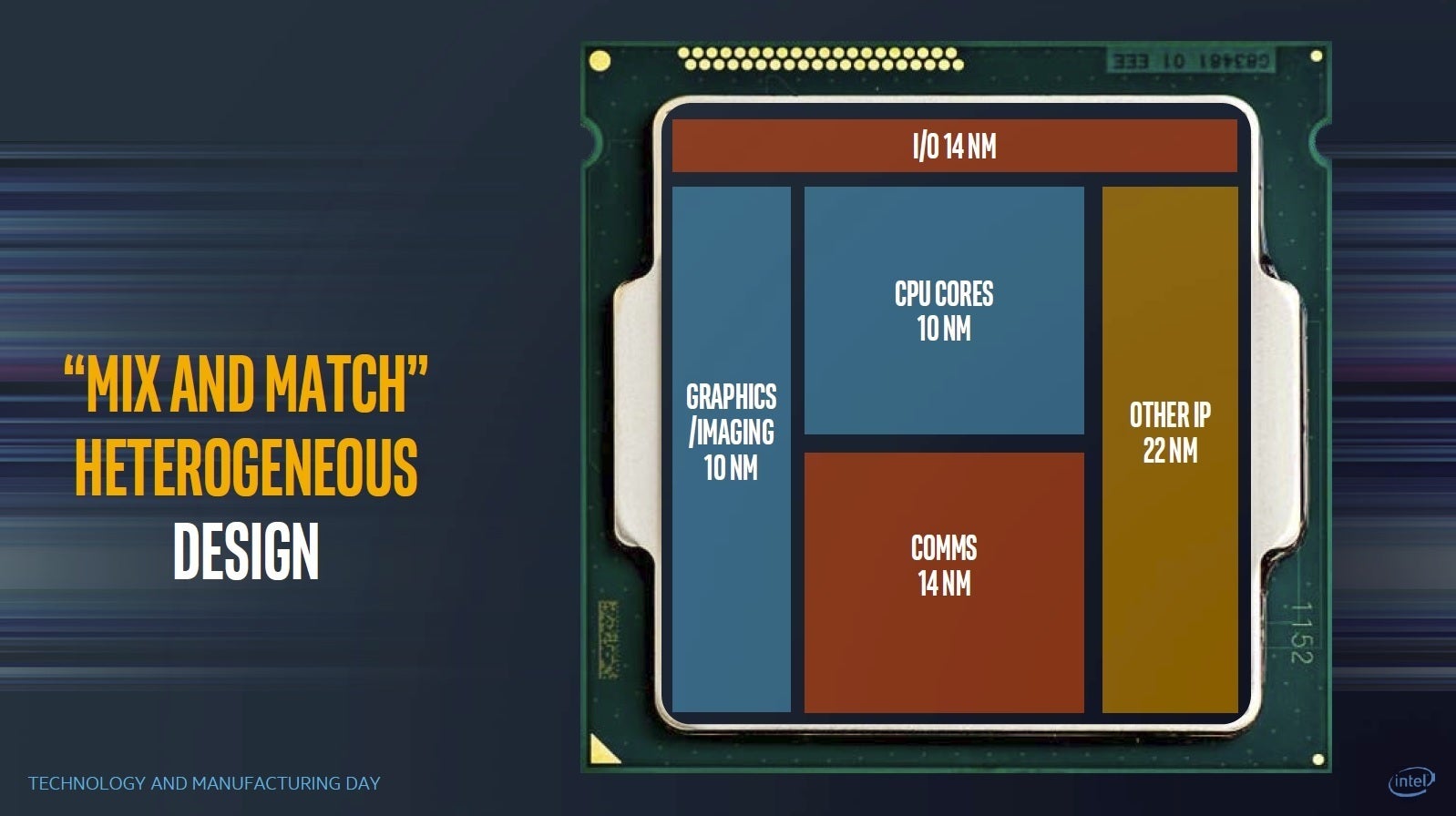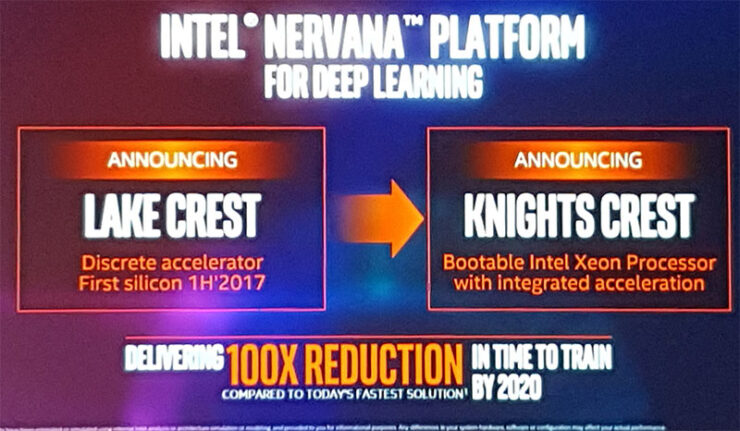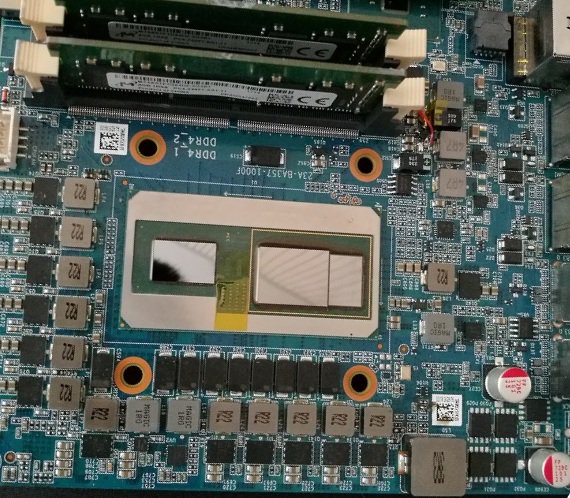I feel AMD has much more chances to sell their GPU with Intel than on its own, at least for now. Ryzen + HBM + 24CU could be really good, but I think most costumers would pick INTEL + NVIDIA laptop. So maybe this is great idea for AMD to get people trust back.
Confirmed by AMD & Intel - Rivals Intel and AMD Team Up on PC Chips to Battle NVidia
Page 13 - Seeking answers? Join the AnandTech community: where nearly half-a-million members share solutions and discuss the latest tech.
You are using an out of date browser. It may not display this or other websites correctly.
You should upgrade or use an alternative browser.
You should upgrade or use an alternative browser.
IntelUser2000
Elite Member
- Oct 14, 2003
- 8,686
- 3,787
- 136
Do you expect Intel to integrate OmniPath in consumer chips?
Why would they need OmniPath in consumer chips?
OmniPath is a competitor to InfiniBand. The technologies are used to connect much further distances than on PCI Express. OmniPath is a rack-to-rack connection while PCIe is within board.
Read the whole thread and you would have already read why Raven Ridge's prospects are hurt by this release. It diminishes AMD OEM and customer mindshare. AMD is basically telling everyone "our chips are for cheap craptops, buy intel chips if you want high-end stuff".
When it doesn't make sense, its because internal conflicts exist within the company. I doubt the surprise will end here.
moinmoin
Diamond Member
- Jun 1, 2017
- 5,248
- 8,463
- 136
Why do you ask me? tamz_msc wrote Intel would be able to one up AMD on HSA with OmniPath of all things:Why would they need OmniPath in consumer chips?
OmniPath is a competitor to InfiniBand. The technologies are used to connect much further distances than on PCI Express. OmniPath is a rack-to-rack connection while PCIe is within board.
If they can make the GPU work with OmniPath instead of PCI-E, then Intel is going to be much ahead of everybody else in enabling true HSA using EMIB.
AtenRa
Lifer
- Feb 2, 2009
- 14,003
- 3,362
- 136
How are laptop sales which include an iGPU and a dGPU calculated (so like every laptop with a dGPU unless we talk DTR niches with iGPU-less Ryzen CPUs)? Same deal here.
Not the same, Laptops have two different products an iGPU (Intel CPU) and a dGPU (AMD or NV), this time there is a single product with an Intel CPU(iGPU as well ??) + a dGPU die on the same package sold to OEMs as an Intel product.
The only way to track the volume of those AMD GPU dies is directly from AMD themselves, or if you have a direct access to Intels Imports of Goods.
PeterScott
Platinum Member
- Jul 7, 2017
- 2,605
- 1,540
- 136
Not the same, Laptops have two different products an iGPU (Intel CPU) and a dGPU (AMD or NV), this time there is a single product with an Intel CPU(iGPU as well ??) + a dGPU die on the same package sold to OEMs as an Intel product.
The only way to track the volume of those AMD GPU dies is directly from AMD themselves, or if you have a direct access to Intels Imports of Goods.
It's the same if you know how to count. It counts as one Intel CPU and one AMD dGPU. Same as in current Apple high end laptops.
AtenRa
Lifer
- Feb 2, 2009
- 14,003
- 3,362
- 136
It's the same if you know how to count. It counts as one Intel CPU and one AMD dGPU. Same as in current Apple high end laptops.
Again, in current Laptops there are two distinct products. An Intel CPU with iGPU sold by Intel and a different product (dGPU die) sold by AMD. This time there is a single product sold by Intel, research firms will have no way of knowing how may of those INTEL Products were shipped each quarter.
PeterScott
Platinum Member
- Jul 7, 2017
- 2,605
- 1,540
- 136
Again, in current Laptops there are two distinct products. An Intel CPU with iGPU sold by Intel and a different product (dGPU die) sold by AMD. This time there is a single product sold by Intel, research firms will have no way of knowing how may of those INTEL Products were shipped each quarter.
Then they have no way of knowing how many Intel CPU's were shipped each quarter, or how many AMD dGPUs either.
tamz_msc
Diamond Member
- Jan 5, 2017
- 3,865
- 3,730
- 136
Eh, seems like a brain fart on my behalf - I was thinking OmniPath to be equivalent to NVlink. But surely Intel can't have made EMIB only to have components connect together using PCI-e, especially high performance parts like GPUs and FPGAs?OmniPath is a competitor to InfiniBand. The technologies are used to connect much further distances than on PCI Express. OmniPath is a rack-to-rack connection while PCIe is within board.
But surely Intel can't have made EMIB only to have components connect together using PCI-e, especially high performance parts like GPUs and FPGAs?
They will once the CPU products that support EMIB are available.
Dayman1225
Golden Member
- Aug 14, 2017
- 1,160
- 996
- 146
When Murthy talked about EMIB at the Manufacturing and Technology day he had this behind himEh, seems like a brain fart on my behalf - I was thinking OmniPath to be equivalent to NVlink. But surely Intel can't have made EMIB only to have components connect together using PCI-e, especially high performance parts like GPUs and FPGAs?

So yeah I assume EMIB will be used for more than just having components connect through PCI E
moinmoin
Diamond Member
- Jun 1, 2017
- 5,248
- 8,463
- 136
EMIB isn't used for the PCIe connection between the CPU and GPU, that's standard tried and true MCM. EMIB is used for connecting HBM to the GPU.Eh, seems like a brain fart on my behalf - I was thinking OmniPath to be equivalent to NVlink. But surely Intel can't have made EMIB only to have components connect together using PCI-e, especially high performance parts like GPUs and FPGAs?
tamz_msc
Diamond Member
- Jan 5, 2017
- 3,865
- 3,730
- 136
I know that, but what I'm asking is whether EMIB supports any other interconnect technology that could potentially be much faster than PCI-e. After all, Intel must haves plans for integrating FPGAs or co-processors like Xeon Phi with their CPUs for HPC-oriented stuff, as they always intended for EMIB.EMIB isn't used for the PCIe connection between the CPU and GPU, that's standard tried and true MCM. EMIB is used for connecting HBM to the GPU.
PeterScott
Platinum Member
- Jul 7, 2017
- 2,605
- 1,540
- 136
I know that, but what I'm asking is whether EMIB supports any other interconnect technology that could potentially be much faster than PCI-e. After all, Intel must haves plans for integrating FPGAs or co-processors like Xeon Phi with their CPUs for HPC-oriented stuff, as they always intended for EMIB.
Do you mean other Protocols?
EMIB is the physical interconnect technology, it won't support other kinds of phyical interconnects, because the whole point is being a fast silicon physical level interconnect. It should be the next fastest physical connection to being inside the same die.
You could run PCIe protocol over EMIB physical connections, but I doubt that would be used very often.
It is more likely in chip to chip communication at this level, you will run something much lighter weight and more custom to the solution at hand.
Dayman1225
Golden Member
- Aug 14, 2017
- 1,160
- 996
- 146
I know that, but what I'm asking is whether EMIB supports any other interconnect technology that could potentially be much faster than PCI-e. After all, Intel must haves plans for integrating FPGAs or co-processors like Xeon Phi with their CPUs for HPC-oriented stuff, as they always intended for EMIB.
They seem to be doing such a thing with Nervana.

Source
The successor to Lake's Crest is named Springs Crest then a year cadence after that. I imagine these are two different product lines.
http://www.barrons.com/articles/int...-leading-the-way-in-a-i-processors-1508873629

I imagine this isn't the only lineup of products that will be using EMIB to do such thing.
Last edited:
LightningZ71
Platinum Member
- Mar 10, 2017
- 2,654
- 3,337
- 136
I imagine that it would be relatively "trivial" to implement PCIe 5.0 on the EMIB and other interposed technologies. 16 lanes of PCIe 5 is a mountain of bandwidth for the next five years or so.
PeterScott
Platinum Member
- Jul 7, 2017
- 2,605
- 1,540
- 136
This still sounds more like a third party using an intel cpu and an amd dgpu in a high end laptop and other people running with scissors saying intel/amd are working together...
I agree.
All the benefits here are from using EMIB to connect the GPU and HBM. It's really more like a commercial test case for EMIB than any kind of CPU/GPU integration.
Having the CPU on the same mini board, apparently not connected by EMIB, but instead using PCIe, doesn't really make it any different than mounting the CPU on main MB separately. They aren't integrated at all.
i-know-not
Junior Member
- Mar 2, 2017
- 13
- 14
- 41
I know that, but what I'm asking is whether EMIB supports any other interconnect technology that could potentially be much faster than PCI-e. After all, Intel must haves plans for integrating FPGAs or co-processors like Xeon Phi with their CPUs for HPC-oriented stuff, as they always intended for EMIB.
The EMIB, like any other physical electrical signal conduit, can support any communications standard as long as its material properties and wire geometry can be tuned to meet the specifications of that standard. Usually the spec involves things like not going above a certain limit on signal loss, signal integrity in the presence of jitter and noise, correct impedance of the conduit, etc.
Given that in this case, the signals have a very small distance to travel, the signal loss could be very low and the EMIB could be able to support much higher data transfer rates than PCIE 3.0
Last edited:
DrMrLordX
Lifer
- Apr 27, 2000
- 23,149
- 13,242
- 136
Why would they need OmniPath in consumer chips?
They wouldn't. NVlink, however . . . oh wait, someone already mentioned that.
Veradun
Senior member
- Jul 29, 2016
- 564
- 780
- 136
***IF TRUE***
WTF kind of signal does this send? Can you read it any other way but "AMD declare their cpus are crap for gaming"?
***IF TRUE***
edit: I suppose, after a minute to absorb it, AMD might be figuring "we're gonna lose the (cpu) sale to the idiot paying over the odds for the badge anyway, might as well make some money despite their stupidity."
[I challenge anyone to come up with a coherent argument why buying an Intel APU is better for games than any equivalent generation AMD APU!]
AMD APUs are supposed to be far lower power than this CPU+GPU glued together (lol). Those products are not in direct competition.
AND this is the best way to cut nVidia away from the mainstream OEM space. They will go Intel iGPU, AMD Raven Ridge, Intel plus iRadeon or higher end Intel/AMD CPU plus dRadeon.
This move, for both AMD and Intel is the first step to try and kill nVidia. Good luck.
Well now, this news could really shake up the PC industry. These CPU + GPU packages, CGPU?,could end up as the in the majority of mid range "gaming" laptops and could roll over into other segments as well. What happens if most laptop and even many desktop designs revolve around this CGPU style package perhaps with other chips (sound) baked in as well. Who is going to pay the premium for systems that allow separate components if the new normal in manufacturing and assembly is the integrated package designs. Intel certainly has the clout to push the industry in that direction. AIB partners should be worried right now. I wonder who Nvidia will be buying their CPUs from to make their own CGPU if that happens? Interesting times ahead.
Last edited:
Beefy looking VRM.
Overkill but they do need to test 100W NUC packages at some point.
TRENDING THREADS
-
Discussion Zen 5 Speculation (EPYC Turin and Strix Point/Granite Ridge - Ryzen 9000)
- Started by DisEnchantment
- Replies: 25K
-
Discussion Intel Meteor, Arrow, Lunar & Panther Lakes + WCL Discussion Threads
- Started by Tigerick
- Replies: 23K
-
Discussion Intel current and future Lakes & Rapids thread
- Started by TheF34RChannel
- Replies: 23K
-
-

AnandTech is part of Future plc, an international media group and leading digital publisher. Visit our corporate site.
© Future Publishing Limited Quay House, The Ambury, Bath BA1 1UA. All rights reserved. England and Wales company registration number 2008885.


